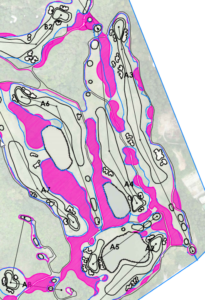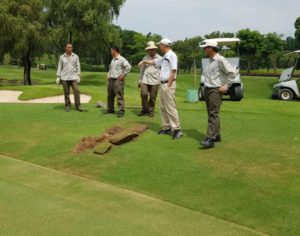
Xili Golf Club in Shenzhen, China has just commenced renovation of its 36-hole irrigation system. The original system was in poor condition and a significantly limiting factor in the turf maintenance and course playability.
The original system was in serious condition with the following limitations:
- Little or no automatic operation and control capability
- Limited coverage and irregular spacing
- No independent irrigation of greens from the surrounds
- Failing pipe, fittings, and valves
- One of the two pump stations is completely antiquated and undersized.
- Undersized mainline
Also, water use restrictions have recently been imposed and the cost of water was increased due to new water use taxes. The government is serious about the water use, as they should be, with cameras on the pump stations meters continually monitoring the use.
Justification
The first step in the renovation process was the realization of the importance of a quality irrigation system by Mark O’Connell, the General Manager. Mark went to great lengths to educate himself on the features, benefits and technical aspects of the many facets of a modern irrigation system, far more than any GM I have ever worked with. The more he learned the more he realized they needed to do it “Right the First Time”. This knowledge he gained gave him the ability to justify the expense to the owner and the importance of not cutting corners.
Design and Procurement
ATI was fortunate to be selected as the irrigation design firm. Once the project was justified for planning, we went to work. The first step in the design process of any course is to acquire an accurate base map. In a renovation, the more accurate the better since the course features are stable, unlike new construction. Shenzhen is the home of DJI, the leader in drone technology. Until this project, we had used more traditional methods of developing base maps such as surveys, satellite imagery, or Google maps. Alex Grengs, Workshop Manager, introduced us to drone technology and mapped the entire 36-holes to include 25cm contours. The results were fantastic! Every course needs a properly flown to-scale drone image as soon as possible. The high-resolution photography allows us to very accurately design the system. As a result, there will be limited changes during installation. Also, the layout is much easier since the sprinkler locations can be referenced to the exact locations on the drone image. This proactive work by Alex, insuring a quality base map, helped set the tone for the rest of the project.

Highly Accurate Designs Can Be Made From Drone Images
In order to provide the owners with the most information possible to aid in their decision making the design was bid with several options including:
- Toro vs Rain Bird
- Decoder vs. Satellite
- Local HDPE PE3408 vs. Imported 4710 Pipe
- Ductile Iron fittings and valves vs HDPE
This menu of options provided actual costs for each so the most educated decisions could be made. In the end, a Toro Smart hub control system with imported PE4710 pipe and fittings from CMF Global from San Diego, CA USA was selected.

Since water restrictions and water costs are significant issues it was important that we reduce the irrigated turf area as much as possible. To assist in this process, GCH Landscape Architects were also hired. We worked closely with them to identify new grass lines to limit the irrigated turf. They will then design the landscape and/or ground covers for the areas taken out of the turf and the landscaping will be installed over time by the club. Landscape irrigation points of connection will be stubbed out so the landscape irrigation can be automated once installed.
Areas In Pink Removed From Turf
Installation
The irrigation installation was bid separately by local contractors. At the end of the day, a determination was made to utilize Shenzhen Zeta Hydric Irrigation Engineering Co., LTD for local installation experience in conjunction with a foreign Quality Control supervisor hired by the club. The majority of the equipment also was provided by the club. Jason MacClellan was hired by the club to oversee the day-to-day installation by the contractor. Jason has significant international irrigation renovation and HDPE pipe experience. The club is also providing some labor to help with the all-important sod replacement and cleanup. This method offered the club the local labor they needed combined with experience at the best price possible. At the end of the installation, they own the equipment as well.
One of the additional benefits of the CMF package is the training provided to the installers by CMF. We all know that crew members come and go and you can’t be sure those who know how to fuse pipe actually know how to do it correctly. There is definitely one right way and several wrong ways to do it. Chris Menno with CMF provided extensive training on the fundamental of fusing to ensure everyone knows how to do it the correct way. Just because a fuse bead looks good to the eye doesn’t mean it was properly done. Each fuse is logged so the staff making the fuse knows they need to do it right.

In a renovation project, it is very important to limit the inconvenience to the members as much as possible. This objective will be implemented in various ways such as:
- Limiting work on weekends to non-play tasks
- Working after dark
- Pulling laterals where feasible to limit turf disruption and increase speed
- Quality sodding and backfilling behind open trenching
One hole at a time will be closed for lateral pipe installation to ensure worker safety as well as safety nets on holes where workers are installing the mainline during play.
Effective Member communication is also a priority. A Member Notice Board Is displayed outside the pro-shop explaining the process to the members with ongoing updates as well as information online such as this video link.

Layout

Sub-centimeter GPS equipment was purchased by the club to assist in the layout process and as-built drawing preparation. The equipment can also be used for any future irrigation or drainage changes. After any adjustments for the new turf lines are provided by the landscape architect the final sprinkler locations are established by ATI. These are then exported from AutoCAD to the GPS equipment for layout in the field.
As is normal with mature courses the greens shrink over time from their original construction. To determine the original perimeters the maintenance team excavated and probed to locate the green barrier. The original perimeter was then GPS mapped and recorded for future use. The greens sprinklers then are installed on the original green so they can be expanded at a later date.


Operation
Computerized irrigation is a new step for the staff at Xili. ATI is working with Howie Zhang the course superintendent to help define the sprinkler station IDs and irrigation preferences. ATI then programs the computer as each hole is installed.
As the system is installed ATI will be working closely with the staff to train them on how to maximize the investment the ownership has made.
Stay tuned for more updates to come on the progress of the Xili Golf Club Irrigation renovation.



